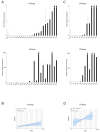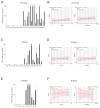The Expression of HPV-16 E5 Oncoprotein Impacts the Transcript Profiles of FGFR2 and EMT-Related Genes in Preneoplastic Anal Epithelium Lesions
- PMID: 39596152
- PMCID: PMC11593544
- DOI: 10.3390/ijms252212085
The Expression of HPV-16 E5 Oncoprotein Impacts the Transcript Profiles of FGFR2 and EMT-Related Genes in Preneoplastic Anal Epithelium Lesions
Abstract
Anal Squamous Cell Carcinoma (SCCA) is a rare Human Papillomavirus type 16 (HPV16)-associated carcinoma whose pathogenesis is still poorly understood. Recent studies based on biopsy and Next Generation Sequencing (NGS) approaches have linked the viral episomal status to aggressive SCCA phenotypes, suggesting a potential role of the 16E5 oncoprotein in tumor development. Our previous findings indicated that 16E5 induces Fibroblast Growth Factor Receptor 2 (FGFR2) isoform switching, aberrant mesenchymal FGFR2c expression, Epithelial Mesenchymal Transition (EMT), and cell invasion in various in vitro human keratinocyte models, as well as in the in vivo context of cervical Low-grade Squamous Intraepithelial Lesions (LSILs). To further explore the role of 16E5 in epithelial carcinogenesis, this study aims to investigate the molecular profile in HPV-related anal lesions. The results showed a significant positive correlation between 16E5 and FGFR2c, as well as 16E5 or FGFR2c and key EMT-related transcription factors, particularly in the group of HPV16 positive anal samples not containing without high grade lesions. Additionally, by coupling the molecular analysis with an interactome investigation, we hypothesized a potential functional interplay between the Ca2+ channel Transient Receptor Potential Ankyrin 1 (TRPA1) and FGFR2c, mediated by 16E5 during the establishment of the oncogenic signaling. These findings will help to elucidate the actual relevance of 16E5 in the early progression of anal lesions and contribute to determine its potential as target for future preventive approaches for HPV16-positive SCCA.
Keywords: E5; FGFR2c; HPV16; TRPA1; epithelial–mesenchymal transition.
Conflict of interest statement
The authors declare no conflict of interest.
Figures







Similar articles
-
Regulation of epithelial growth factor receptors by the oncoprotein E5 during the HPV16 differentiation-dependent life cycle.Tumour Virus Res. 2025 Jun;19:200315. doi: 10.1016/j.tvr.2025.200315. Epub 2025 Mar 7. Tumour Virus Res. 2025. PMID: 40057277 Free PMC article. Review.
-
Expression of the E5 Oncoprotein of HPV16 Impacts on the Molecular Profiles of EMT-Related and Differentiation Genes in Ectocervical Low-Grade Lesions.Int J Mol Sci. 2021 Jun 18;22(12):6534. doi: 10.3390/ijms22126534. Int J Mol Sci. 2021. PMID: 34207106 Free PMC article.
-
HPV16 E5 expression induces switching from FGFR2b to FGFR2c and epithelial-mesenchymal transition.Int J Cancer. 2015 Jul 1;137(1):61-72. doi: 10.1002/ijc.29373. Epub 2014 Dec 13. Int J Cancer. 2015. PMID: 25450802
-
HPV16 E5 affects the KGFR/FGFR2b-mediated epithelial growth through alteration of the receptor expression, signaling and endocytic traffic.Oncogene. 2011 Dec 15;30(50):4963-76. doi: 10.1038/onc.2011.203. Epub 2011 May 30. Oncogene. 2011. PMID: 21625213
-
HPV infection and intraepithelial lesions from the anal region: how to diagnose?Braz J Infect Dis. 2011 Sep-Oct;15(5):473-7. doi: 10.1016/s1413-8670(11)70230-6. Braz J Infect Dis. 2011. PMID: 22230855 Review.
Cited by
-
Regulation of epithelial growth factor receptors by the oncoprotein E5 during the HPV16 differentiation-dependent life cycle.Tumour Virus Res. 2025 Jun;19:200315. doi: 10.1016/j.tvr.2025.200315. Epub 2025 Mar 7. Tumour Virus Res. 2025. PMID: 40057277 Free PMC article. Review.
-
Treatment and Prevention of HPV-Associated Skin Tumors by HPV Vaccination.Vaccines (Basel). 2024 Dec 20;12(12):1439. doi: 10.3390/vaccines12121439. Vaccines (Basel). 2024. PMID: 39772099 Free PMC article. Review.
References
-
- Li Y., Xu C. Human Papillomavirus-Related Cancers. Adv. Exp. Med. Biol. 2017;1018:23–34. - PubMed
-
- Mukherjee A.G., Ramesh Wanjari U., Valsala Gopalakrishnan A., Jayaraj R., Katturajan R., Kannampuzha S., Murali R., Namachivayam A., Prince S.E., Vellingiriet B., et al. HPV-associated cancers: Insights into the mechanistic scenario and latest updates. Med. Oncol. 2023;40:212. doi: 10.1007/s12032-023-02085-8. - DOI - PubMed
-
- Brant A.C., Menezes A.N., Felix S.P., De Almeida L.M., Sammeth M., Moreira M.A. Characterization of HPV integration, viral gene expression and E6E7 alternative transcripts by RNA-Seq: A descriptive study in invasive cervical cancer. Genomics. 2019;111:1853–1861. doi: 10.1016/j.ygeno.2018.12.008. - DOI - PubMed
MeSH terms
Substances
Grants and funding
LinkOut - more resources
Full Text Sources
Medical
Research Materials
Miscellaneous

